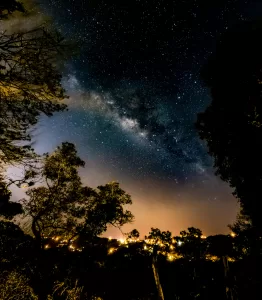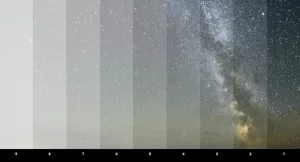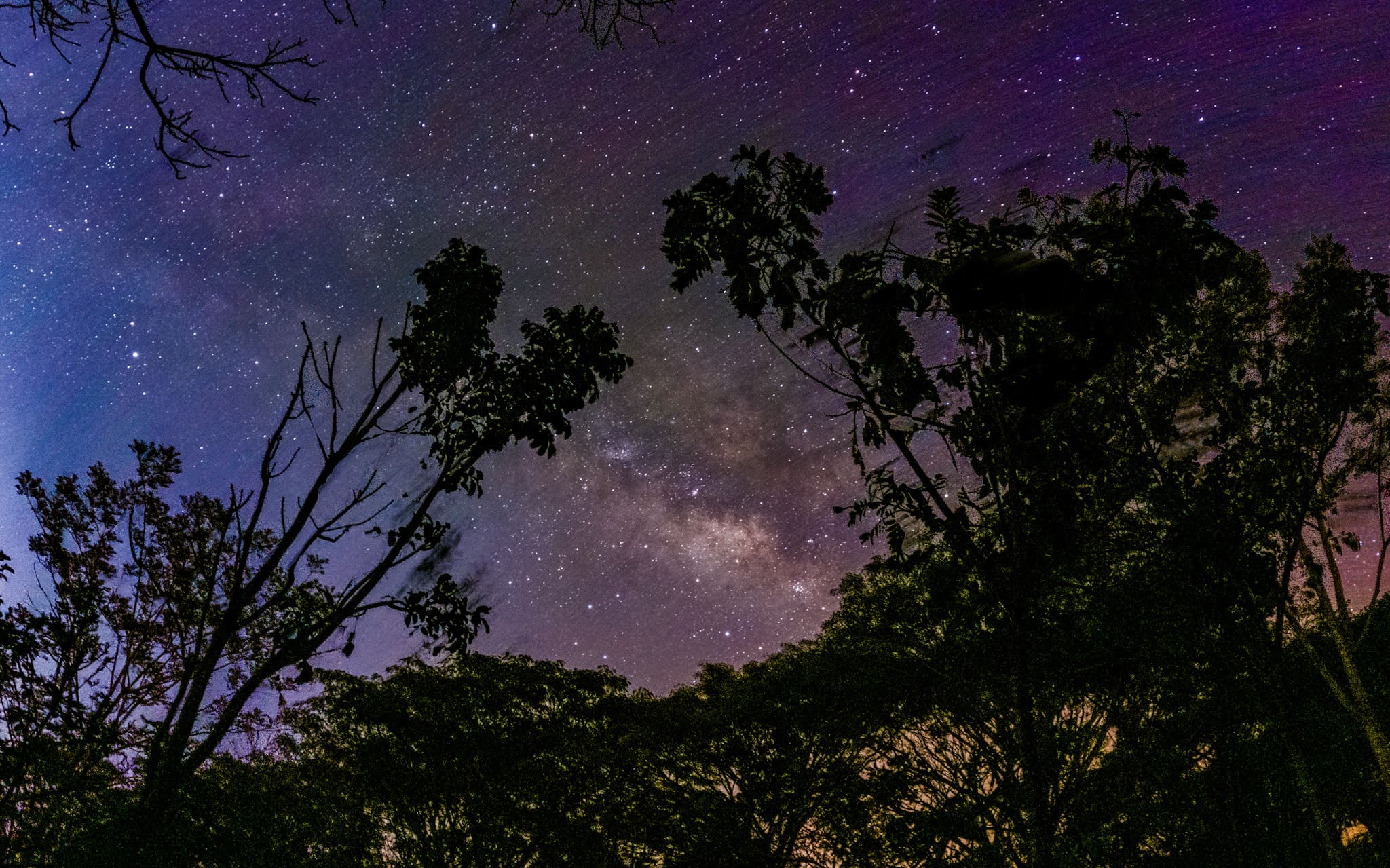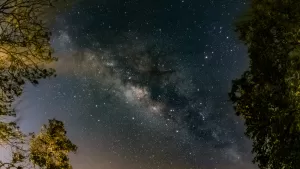Astro tourism, which encompasses dark-sky tourism, eclipse chasing, mindful stargazing, astrophotography , star-bathing, or just plain star watching , is a form of nature-based tourism specifically concerned with the viewing of celestial objects, space, and the physical universe. It involves traveling to areas where astronomic events are occurring ( like an eclipse) or going to areas devoid of any light pollution, crowds, and traffic, where one can focus solely on the dark skies above and while away hours gazing at the stars, planets, and constellations overhead. It presents a wonderful alternative to traditional vacations.
Publications such as Conde Nast Traveler, Vogue, many travel sites and blogs have identified Astro tourism as the #1 trend for 2024. There are good reasons for this burgeoning interest in the heavens.
The sky is brightening by around 10 percent every year and the research suggests that due to light pollution , the Milky Way is already invisible to as many as 80% of Americans and a third of the world’s population. Studies have shown that light pollution affects our health , and disturbs our sleep, so many are seeking the wellness and recuperation provided by getting away from cities and lights , and sleeping in natural darkness. The aftermath of the COVID pandemic lockdowns has driven a longing for many to connect with nature, and get away from crowds. The fact that North America has had three solar eclipses in 8 years has also piqued interest . The more society falls deeper into an ever-expanding virtual world, the more many feel a need to broaden their horizons into something tangible and real . FInally, to many, it brings a sense of awe and connection to the cosmos in a spiritual way.
Astro tourism has grown so much in the past few years that many wellness-centric hotels have started creating space and programs for clients. Some states in the US, like Utah, have an entire tourist department focused on outreach to astro tourists. The entire nation of New Zealand is focused on dark sky tourism.
So , what is the state of Astro tourism here in Costa Rica?
For the most part, it is a nascent segment of the international tourism industry. In fact, it reminds me of where Birdwatching was 25 years ago when we first started coming to Costa Rica. It is one of the tourism segments that actually is more developed for national tourists than international. The biggest group in Costa Rica is Cientec ( https://cientec.or.cr/ ) who hold talks and single or multiple night ‘Star Parties ‘, where they supply some telescopes and many people bring their own, and view the night sky in a group. They offered a trip to last year’s Annular Eclipse and have one planned for Mexico this year. They also started last year working with the Costa Rica Tourism Institute and the Spanish Starlight Foundation (www.fundacionstarlight.org/) to develop accreditation for locations in Costa Rica.
There are also several special interest Facebook groups in the country
Astrónomos Aficionados CR
https://www.facebook.com/groups/123428148166818
Grupo de Astronomía L10n Costa Rica
https://www.facebook.com/groups/604747849941230
The Magic Night CR
https://www.facebook.com/TheMagicNightCr
All these groups inform when night sky events like meteor showers, lunar eclipses, and even sights like the passing of the International Space Station are coming, share astro photos, have workshops on astronomy and astrophotography, and hold star parties.
Internationally, while some websites mention it, and a few hotels offer the opportunity for night tours, there is only one travel group , Travel Quest, that has a yearly Astro tourism trip to Costa Rica , and always in March. I‘ll explain why , and why you should be thinking about getting out to watch the skies in the next few months.
 So where and when do you go in Costa Rica to view the heavens ?
So where and when do you go in Costa Rica to view the heavens ?
You need to go somewhere dark, and at a time when what you want to see is visible. Sounds simple? Well, not exactly .
You’ll need dark skies. How do you find them? Dark Sky International ( https://darksky.org/) is the best resource for dark sky locations and they are the foremost group in the world helping towns and cities all over the world minimize light pollution and grow astro tourism. You can look up on an interactive map how dark the night skies are where you want to go ( https://www.lightpollutionmap.info/ ), but to understand how to read the map, you will need to understand the Bortle Scale.

The Bortle Scale is a nine-level numeric scale that measures the brightness of the night sky. 1 is totally dark sky, little to no light pollution – the perfect night sky. 2-3 are still really nice dark sky viewing. Above 4 or 5 you cannot really see things like the Milky Way , and above 6 there is little or no night sky. For more information of the Bortle scale, here is a link : https://astrophotographylens.com/blogs/astro/bortle-scale
In Costa Rica, there are many places where you can get 4 or less on the Bortle scale. Most of them are along the coasts ,or on the top of mountains ( Irazu and Cerro de la Muerte are popular sky party sites) , or in really remote rural places . So you can find many good Bortle 2-4 locations.
The other important aspect is what you can actually see . We are a mountainous country so you need to keep that in mind when planning night sky viewing . This is the reason the coastlines and tops of mountains are the better locations for viewing, they have a line of sight from level to 90°. There are tools that can help you determine what you can see. I have two favorites : The first is an app and website called Stellarium (https://stellarium-web.org/) . It will allow you to see an image of the night sky at your exact location so you can see what you will see at night. It tracks planets and the moon also, so if you want a dark moonless night, it helps, as it does if you want a full moon photo . The other app I use is called PhotoPills , and is useful if you are interested in astrophotography. It helps you plan your shots ahead of time, with a really wild Augmented Reality feature that allows you to see the night sky superimposed over what you are seeing with your phone camera.
So when is the best time for Astro tourism here in Costa Rica?
Costa Rica is close to the equator, so it is a really interesting place to view the night sky, especially if you want to see celestial sights you cannot in the more northern latitudes. The best time of year starts in February and goes until October, but with the rainy season, the peak months are February – April, with the peak in early April. In fact, International Dark Sky week is celebrated the first week of April. (https://idsw.darksky.org/#what-is )
The reason this is the best time of year is that, beginning in early February, the best and brightest part of the Milky Way, the Galactic center , along with the still visible Southern Cross ( yes, we can see the Southern Cross in Costa Rica) , rises above the horizon line. This makes the Milky Way viewing amazing in these months. This year, the best viewing will be the moonless nights in mid February, again in mid March , then finally the peak in early April. The show continues, but clear nights become an issue for the rest of the season. The trick to seeing the Milky Way is to look south when you are in the Northern hemisphere and to look south when you are in the Southern hemisphere. You read that correctly, you always look south for the Milky Way: The Milky way is better the further south you are , and thus being close to the equator, Costa Rica is a great location to see the southern sky. Areas, especially along the coast, that have a dark view to the south over the water are wonderful viewing opportunities . Cloudless nights are necessary, and this time of year they are almost guaranteed on the Pacific side of the country, while the Eastern side of the country can get clouds from cold fronts. The tip of Nicoya, Palo Verde, the central Pacific from Jaco to Esterillos and Osa are popular viewing spots . Going to higher elevations such as Poas, Irazu and the Dota region are also great locations.
In addition to the sun and the sand, the waterfalls and jungle, the monkeys and sloths, the toucans and macaws – add looking up at night to the must do things while in Costa Rica.







